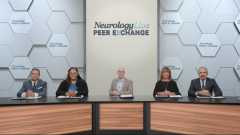
S1P Receptor Modulator Treatment in Female Patients with MS
Stephen Krieger, MD; Daniel Bandari, MD, MS; Bruce Hughes, MD; Mitzi Williams, MD; and Heidi Crayton, MD, review data on ponesimod vs teriflunomide for the treatment of female patients with multiple sclerosis who are of childbearing age.
Episodes in this series

Stephen Krieger, MD: Another advantage in that respect might be family planning considerations. We can talk a bit about that. Obviously, we treat a lot of women of childbearing age and potential with our medicines. Let’s speak about how you stop or adjust the use of medicines, in particular the newer oral agents, if one of your patients wants to get pregnant.
Heidi Crayton, MD: I think it’s something that’s an important part of what we do in our conversations with our younger patients, the discussion about family planning and when that might take place, when they’re thinking about that. If they haven’t started a therapy, that’s a huge part of the consideration, in terms of directing toward an appropriate DMT [disease-modifying therapy]. When they are already on a product, I think that’s something we have to have a conversation with them about early, in terms of deescalating, with the goal of stopping with most of our products, in their time frame.
Stephen Krieger, MD: Historically in our field, 1 oral medicine, teriflunomide, had been considered pregnancy Category X when it was first approved. So, we don’t often use that in women who are likely to want to conceive. It’s worth saying because the pivotal study of one of our newer selective S1P [sphingosine-1-phosphate receptor] modulators, ponesimod, was a ponesimod vs teriflunomide study, which showed the superiority of ponesimod in their primary outcomes and led to the approval of that agent. But what about ponesimod vs teriflunomide in women of childbearing age and potential?
One of the more recent projects or carveouts of those data was presented here at the Congress of ECTRIMS [European Committee for Treatment and Research in Multiple Sclerosis]. This…looked at how well ponesimod worked in women of childbearing age and potential. And thankfully, perhaps unsurprisingly, it showed that the reductions in annualized relapse rates and the other primary end points were well seen in that population. So, it gives us more comfort in using this class of medicine, and avoiding perhaps a medicine like teriflunomide, which would have more pregnancy implications and require an accelerated elimination, which the S1Ps do not require, as Dr Williams said, they can come out of the system more quickly, the more recent ones. Those are nice data to talk about both safety and efficacy in that particular population.
Transcript edited for clarity
Newsletter
Keep your finger on the pulse of neurology—subscribe to NeurologyLive for expert interviews, new data, and breakthrough treatment updates.













































